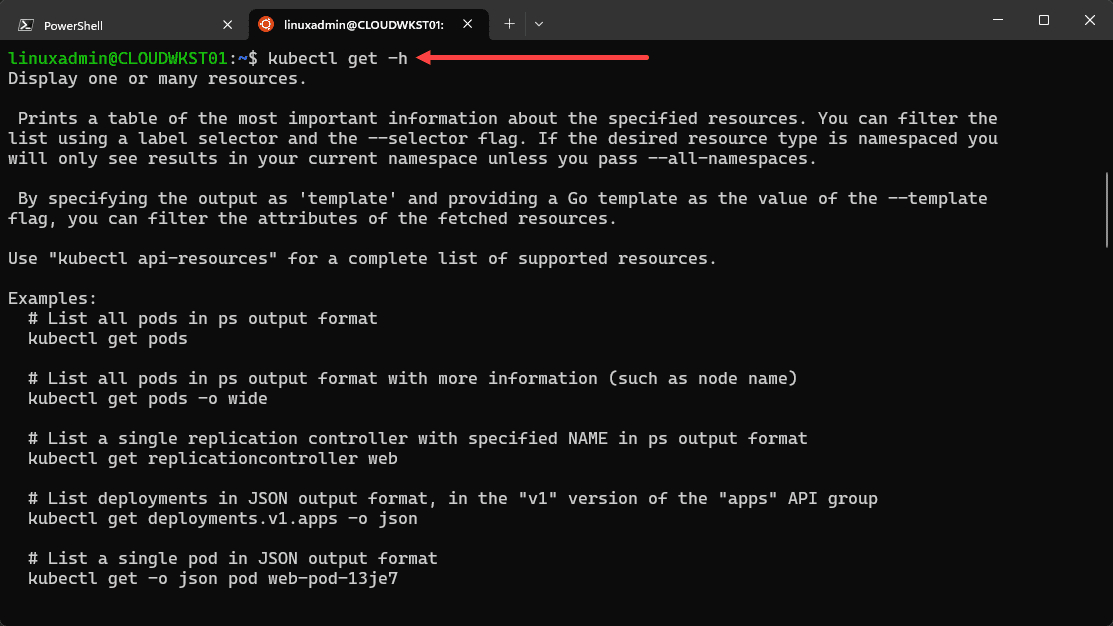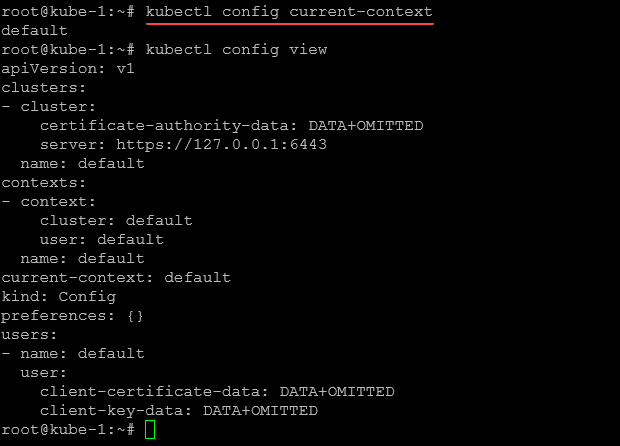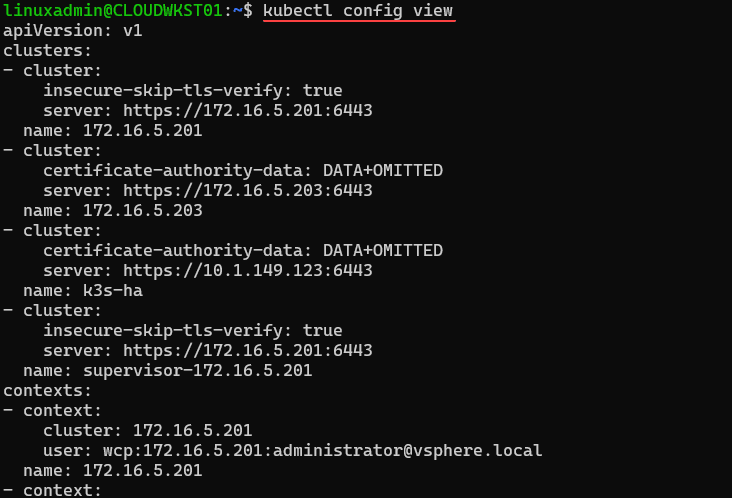
kubectl, a command line tool, facilitates direct interaction with the Kubernetes API server. Its versatility spans various operations, from procuring cluster data with kubectl get context to manipulating resources using an assortment of kubectl commands.
Comprehending Fundamental Kubectl Commands
Before diving into K8s context management, it’s essential to understand the beginner concepts and operation of kubectl. Even the simple command kubectl get can extract valuable information from a Kubernetes cluster.
If you want to see instances of the kubectl get command, execute the command listed below:
kubectl get -hIn addition to the above command, let’s see how to manage multiple Kubernetes clusters.
Working with More Than One Kubernetes Cluster
When you have lots of Kubernetes clusters, managing them can seem hard. But that’s where context switching and kubectl config commands help. A context in kubectl is like a link to a Kubernetes cluster. It holds the cluster name, the default namespace, and the default user. Whenever you connect to a Kubernetes cluster, it makes a context entry.
Managing contexts becomes really important when working with many Kubernetes clusters. By using kubectl config get-contexts, you can see all the contexts you have available.
The kubectl config current-context command helps identify the current context, among possibly many Kubernetes contexts.
Navigating Contexts with kubectl config
The kubectl config command opens up a range of possibilities. You can use the kubectl config view command to see all the details of your kubeconfig file,
kubectl config viewTo create a new context or modify an existing one:
kubectl config set context Below, I have a single context entry in the kubeconfig file.
In the following environment, I have a kubeconfig file with multiple entries.
You can use the following command to switch between multiple contexts.
kubectl config use-contextLet’s say you have two clusters, clusterA and clusterB. After setting clusterA as your current context, you could run the following command:
kubectl config set context clusterB You could follow that with the below to make clusterB your new current context.
kubectl config use-context clusterB Creating a New Context
One of the most commonly used kubectl config commands is kubectl config set context. To create a new context, you must know your cluster name, namespace, and user credentials.
Once you have these, use the command below with the required parameters:
kubectl config set contextThe Power of Context Switching
The ability to switch between multiple Kubernetes clusters with a simple kubectl config use-context command is a significant advantage. It allows developers to manage resources across various clusters seamlessly. The kubectl config current-context command also keeps you aware of your current operational context.
Overseeing Kubernetes Resources
When you’ve got context management sorted out, you can then branch out to other kubectl commands. The kubectl command line tool shows how flexible it is when you start creating new deployments with kubectl create or when you access pod logs with kubectl logs.
Getting pod information is a snap with kubectl describe. Need to modify resources? Use kubectl scale. If file transfer is your requirement, kubectl cp is at your service. And for verifying access, there’s kubectl auth. Every command is a useful aid in managing Kubernetes clusters more efficiently, ensuring a seamless operation.
Troubleshooting with kubectl
Should you encounter issues, the kubectl command line tool is equally capable of troubleshooting. It provides a variety of commands to view and manage your Kubernetes objects and even allows you to access parameters of your resources for efficient debugging.
Frequently Asked Questions
How Can I Install the kubectl Command Line Tool?
Installation of kubectl is usually specific to your operating system. In general, you would download the latest stable version of kubectl from the Kubernetes release artifact site. Always verify the binary against the checksum file.
What is a Kubeconfig File, and How is it Utilized?
The kubeconfig file is a configuration file that stores information about the clusters, namespaces, and authentication mechanisms that kubectl should use when interacting with different Kubernetes clusters. It’s often set using the KUBECONFIG environment variable.
How Can I Understand the Current Context Better?
Understanding the current context is crucial for kubectl operations. The kubectl config current-context command is useful to check which context is currently in use. Additionally, kubectl config get-contexts lists all available contexts.
What Does the Command kubectl config set context Do?
The kubectl config set context command allows you to create or modify contexts. It’s a powerful tool when working with multiple Kubernetes clusters as you can quickly switch your operational focus between different clusters.
What Role Do User Credentials Play in Contexts?
User credentials are key elements in the definition of a context. They define the default user for the specific context, influencing the access and permissions for operations on the Kubernetes cluster.
How Can I Copy Files Between a Container and My Local Filesystem?
The kubectl cp command is handy for this. With it, you can copy files or directories between a container and your local filesystem.
Can I Modify the Default Namespace in a Context?
Yes, with the kubectl config set-context command, you can change the default namespace of the current context. It’s particularly useful when working with different namespaces across various projects.
How Can I Use kubectl to Inspect the State of Resources?
Many kubectl commands allow for inspecting Kubernetes resources. For instance, kubectl describe gives detailed information about a specific resource, and kubectl get lists resources of a particular type.
Juggling Multiple kubeconfig Files
Can you work with several kubeconfig files at once? Absolutely. By setting the KUBECONFIG environment variable, you can manage multiple kubeconfig files. This variable holds the locations of different kubeconfig files, and kubectl commands gather information from these files.
Adopting a Declarative Approach to Managing Kubernetes Resources
Indeed, kubectl endorses a declarative mode enabling Kubernetes resource management via manifest files. In this method, you lay out the intended state of the system in a yaml file, and kubectl works to align the actual state with your outlined specifications.
Managing Kubernetes Objects
You can handle Kubernetes objects using kubectl commands. For example, kubectl create helps in making new resources, kubectl delete removes resources, and kubectl apply puts changes into effect on resources. These capabilities make kubectl a handy tool for looking after Kubernetes resources.
What if I Need to Automate kubectl Commands?
You can automate kubectl commands by using scripts. To improve usability, kubectl even provides autocompletion scripts for Bash and Zsh. You can use the kubectl completion bash command to generate the script for Bash.
Wrapping up
We have looked at the importance of understanding kubectl get context and other related commands. These commands allow for the efficient management of Kubernetes clusters and resources, which is especially beneficial when managing multiple clusters.
Applying these commands well can help you handle a variety of tasks and situations. They assist in swapping contexts, picking your preferred default context, or managing Kubernetes resources across multiple clusters. No matter how complex your Kubernetes setup is, becoming good at the kubectl command line tool will be a big help.
Always remember, every kubectl command has a specific job. When you use it right, it can make working with Kubernetes a whole lot easier.







0 Comments